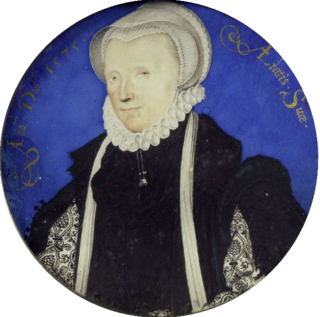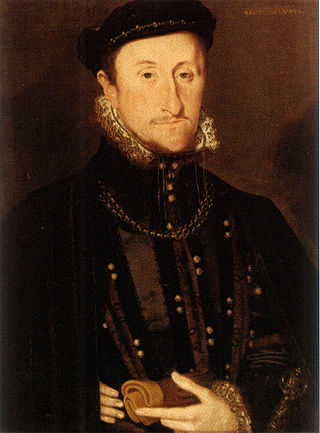Related Research Articles

Mary of Guise, also called Mary of Lorraine, was Queen of Scotland from 1538 until 1542, as the second wife of King James V. She was a French noblewoman of the House of Guise, a cadet branch of the House of Lorraine and one of the most powerful families in France. As the mother of Mary, Queen of Scots, she was a key figure in the political and religious upheaval that marked mid-16th-century Scotland, ruling the kingdom as queen regent on behalf of her daughter from 1554 until her death in 1560.

Margaret Douglas, Countess of Lennox, was the daughter of the Scottish queen dowager Margaret Tudor and her second husband Archibald Douglas, 6th Earl of Angus, and thus the granddaughter of King Henry VII of England and the half-sister of King James V. She was the grandmother of King James VI and I.
Archibald Campbell, 5th Earl of Argyll was a Scottish nobleman, peer, and politician. He was one of the leading figures in the politics of Scotland during the reign of Mary, Queen of Scots, and the early part of that of James VI.

The ruins of Linlithgow Palace are located in the town of Linlithgow, West Lothian, Scotland, 15 miles (24 km) west of Edinburgh. The palace was one of the principal residences of the monarchs of Scotland in the 15th and 16th centuries. Although maintained after Scotland's monarchs left for England in 1603, the palace was little used, and was burned out in 1746. It is now a visitor attraction in the care of Historic Environment Scotland.

James Stewart, 1st Earl of Moray was a member of the House of Stewart as the illegitimate son of King James V of Scotland. At times a supporter of his half-sister Mary, Queen of Scots, he was the regent of Scotland for his half-nephew, the infant King James VI, from 1567 until his assassination in 1570. He was the first head of government to be assassinated with a firearm.

Janet Stewart, Lady Fleming, called la Belle Écossaise, was a Scottish courtier. She was an illegitimate daughter of King James IV of Scotland who served as governess to her half-niece Mary, Queen of Scots. Janet was briefly a mistress of King Henry II of France, by whom she had a legitimated son: Henri d'Angoulême. Her daughter, Mary Fleming, was one of the young queen's "Four Marys".
Robert Stewart, 1st Earl of Orkney and Lord of Zetland (Shetland) was a recognised illegitimate son of James V, King of Scotland, and his mistress Eupheme Elphinstone. Robert Stewart was half-brother to Mary, Queen of Scots and uncle to James VI and I of Scotland and England.
Anne Hamilton, Countess of Huntly, was a Scottish noblewoman and a member of the powerful Hamilton family which had a strong claim to the Scottish crown. Her father James Hamilton, Duke of Châtellerault, 2nd Earl of Arran was heir presumptive to the throne of Scotland after Mary, Queen of Scots prior to the birth of the latter's son Prince James in 1566. Anne was the wife of George Gordon, 5th Earl of Huntly, Lord Chancellor of Scotland and a chief conspirator during the reign of Queen Mary.

Kinneil House is a historic house to the west of Bo'ness in east-central Scotland. It was once the principal seat of the Hamilton family in the east of Scotland. The house was saved from demolition in 1936 when 16th-century mural paintings were discovered, and it is now in the care of Historic Environment Scotland. The house now consists of a symmetrical mansion built in 1677 on the remains of an earlier 16th- or 15th-century tower house, with two rows of gunloops for early cannon still visible. A smaller east wing, of the mid 16th century, contains the two painted rooms. The house is protected as a Category A listed building.
John Gordon, 11th Earl of Sutherland (1525–1567) was a Scottish magnate. John Gordon supported the chief of his family, his cousin the Earl of Huntly against the Earl of Moray. After Huntly's defeat at Corrichie, he went into exile, and shortly after his return to Scotland he was murdered by a kinswoman.
John Chisholm was a 16th-century Scottish soldier and the chief officer, Comptroller and Prefect of the Scottish artillery for Mary, Queen of Scots and James VI of Scotland. He was also keeper of the King's Wark in Leith. Chisholm was a supporter of Mary, Queen of Scots in the years after her exile in England.
Margaret Stewart, Mistress of Ochiltree was a courtier in the household of Anne of Denmark in Scotland and looked after her children Prince Henry, Princess Elizabeth, and Charles I of England

Robert Beaton of Creich was a Scottish landowner and courtier. He served as a Master of Household to Mary, Queen of Scots.
Margaret Beaton, Lady Reres was a Scottish courtier and companion of Mary of Guise and Mary, Queen of Scots. She was blamed by the enemies of Mary, Queen of Scots, for her involvement in alleged immorality at court.
Elizabeth Stewart, Countess of Arran was a Scottish noblewoman and political intriguer. Several accounts of her actions and ambition were written by her political enemies.

John Stewart, Commendator of Coldingham (1531–1563) was a Scottish landowner.
Marie Pieris, Lady Seton was a French lady in waiting at the Scottish court.

The wardrobe of Mary, Queen of Scots, was described in several contemporary documents, and many records of her costume have been published.
Janet Stewart, Lady Ruthven was a Scottish noblewoman.
Bertrand de Salignac de la Mothe-Fénelon (1523-1589) was a French diplomat who served as ambassador to Elizabeth I in England and to James VI in Scotland.
References
- ↑ Marshall, Rosalind Kay. Queen Mary's Women: Female Relatives, Servants, Friends and Enemies of Mary, Queen of Scots (John Donald, 2006). ISBN 0-85976-667-5, ISBN 978-0-85976-667-8
- ↑ Gordon Donaldson, Scotland's History: Approaches and Reflections (Scottish Academic Press, 1995), p. 71, (names her mother "Jean")
- ↑ Rosalind K. Marshall, Mary of Guise (London: Collins, 1978), p. 73.
- ↑ Clare Hunter, Embroidering Her Truth: Mary, Queen of Scots and the Language of Power (London: Sceptre, 2022), p. 126.
- ↑ James Balfour Paul, Accounts of the Treasurer, vol. 7 (Edinburgh, 1907), p. 165.
- ↑ Athol Murray, 'Pursemaster's Accounts', Miscellany of the Scottish History Society X (Edinburgh, 1965), p. 43.
- ↑ Accounts of the Lord High Treasurer of Scotland, vol. 7 (Edinburgh, 1907), pp. 89, 148, 410.
- ↑ James Balfour Paul, Accounts of the Treasurer, vol. 7 (Edinburgh, 1907), pp. 477-8.
- ↑ Marguerite Wood, Balcarres Papers, 1 (Edinburgh: SHS, 1923), p. 83.
- ↑ Rosalind K. Marshall, "Hir Rob Ryall: the Costume of Mary of Guise", Costume, 12:1 (1978), p. 8. doi : 10.1179/cos.1978.12.1.1: Correspondance diplomatique de Bertrand de Salignac de La Mothe-Fénelon, 5 (Paris, 1840), p. 411.
- ↑ Marguerite Wood, Balcarres Papers, 2 (Edinburgh: SHS, 1925), pp. 303, 306
- ↑ Jane Dawson, "The Earl of Argyll and Divorce", Julian Goodare & Alasdair A. Macdonald, Sixteenth-Century Scotland (Brill, 2008), p. 154.
- ↑ Michael Pearce, The Dolls of Mary Queen of Scots: Edinburgh Castle Research Reports (Edinburgh, Historic Environment Scotland, 2018), p. 20
- ↑ Jane Dawson, "The Earl of Argyll and Divorce", Julian Goodare & Alasdair A. Macdonald, Sixteenth-Century Scotland (Brill, 2008), p. 155.
- ↑ Colegate. Colegate's Guide. p. 22.
- ↑ James Balfour Paul, Accounts of the Treasurer, vol. 11 (Edinburgh, 1916), p. 512.
- ↑ John Guy, My Heart is My Own: Mary, Queen of Scots (London, 2004), pp. 185-6, 529: Joseph Bain, Calendar of State Papers Scotland, vol. 2 (Edinburgh, 1900), p. 28 no. 41.
- ↑ John Parker Lawson, History of Scotland by Robert Keith, 2 (Edinburgh: Spottiswoode Society, 1845), pp. 208–209
- ↑ John Parker Lawson, History of Scotland by Robert Keith, 2 (Edinburgh, 1845), p. 413
- ↑ David Hay Fleming, Mary Queen of Scots (London, 1897), p. 426 fn. 99:Calendar State Papers Venice, vol. 7 (London, 1890), pp. 386-7.
- ↑ Correspondance diplomatique de Bertrand de Salignac de La Mothe-Fénelon, 5 (Paris, 1840), p. 411.
- ↑ William Boyd, Calendar State Papers Scotland: 1571-1574, vol. 4 (Edinburgh, 1905), pp. 557, 570, 599, 678, see British Library Cotton C IV, f. 89v & f.100.
- ↑ William Boyd, Calendar State Papers Scotland: 1581-1583, vol. 6 (Edinburgh, 1914), p. 466: Bowes Correspondence (London, 1842), p. 447.
- ↑ Letters to the Argyll Family (Edinburgh, 1839), pp. 75-8.
- ↑ RCAHMS, Inventory of Monuments in Edinburgh (HMSO, 1951), p. 136